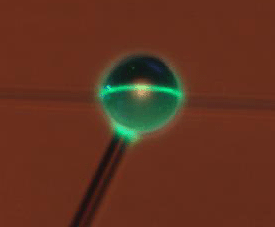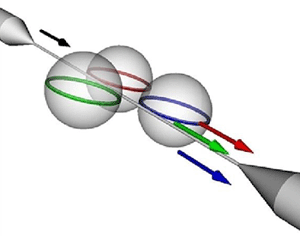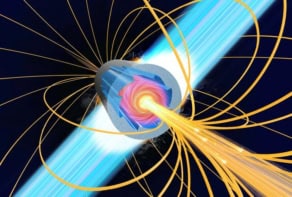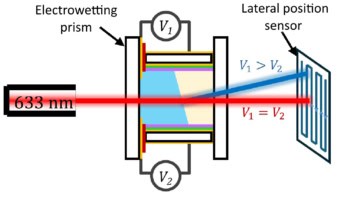A highly efficient microlaser has been made from beads of silica just tens of micrometres wide. According to Kerry Vahala and colleagues of the California Institute of Technology in the US, the laser runs on a thousand times less power than similar devices. Besides being a compact and versatile laser source, the device could be used to probe the quantum nature of light and may have applications in fibre-optic communications (S Spillane et al 2002 Nature 415 621).

A conventional laser is based on an optically active material that emits light when it is excited by an electrical current or another laser. Mirrors reflect this light back and forth through the material, stimulating more light emission and leading to an intense beam of coherent light.
In the ‘microsphere’ laser, this amplification step takes place in a silica sphere placed between the tapered ends of two optical fibres. Laser light shines out of one fibre into the sphere and circulates around its inside surfaces in a so-called whispering-gallery mode. The light intensity grows as light continues to enter the sphere. When the power of the incident light beam is raised above a certain level, the circulating wave escapes from the spheres as coherent radiation, which is detected by the second optical fibre.
The ‘microsphere’ laser also emits radiation over a range of wavelengths because the silica beads shift the wavelength of the incoming light. This effect is known as Raman scattering.
A drawback of the technique is that the volume of small silica spheres is very sensitive to fluctuations in temperature, and this affects the spectrum of the light they emit. In their current set-up, Vahala and co-workers achieved an efficiency ‘quality factor’ of 108 – an order of magnitude lower than previous experiments – but they are optimistic that better temperature control will allow them to use smaller spheres and improve this figure.
‘We have found a way to efficiently couple light into microscopic glass spheres while preserving the exquisite perfection of the sphere in terms of its ability to store and concentrate light,’ Vahala told PhysicsWeb. ‘We knew this property might give us access to the nonlinear physics of the glass itself, but now we need vastly less power than would normally be required.’
Vahala and colleagues point out that several microsphere lasers could be incorporated into a single optical fibre. They believe that their device could be used to investigate various phenomena in quantum electrodynamics and a wide range of nonlinear optical effects. Its compatibility with optical fibres could also make it useful in the communications industry.



